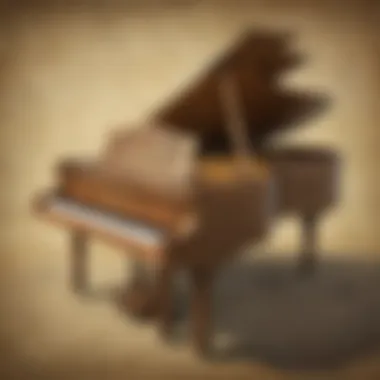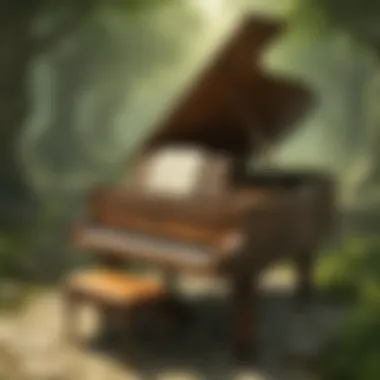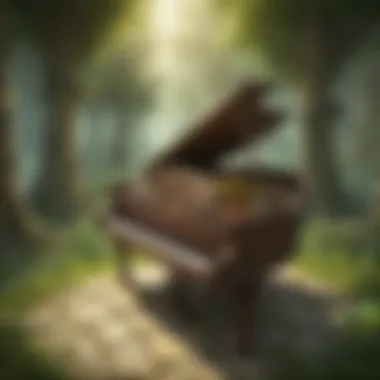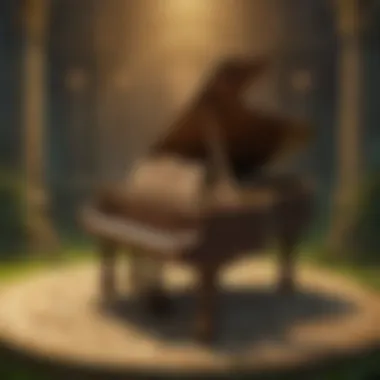Zelda Piano Music: Mastering Iconic Themes


Intro
The music of the Zelda series is not just background noise; it is a central element that enhances gameplay and emotional engagement. For many players, the melodies evoke a deep sense of nostalgia and connection to the game’s world. This guide aims to explore the intricacies of playing this evocative music on the piano. Through an in-depth examination of various themes, accessible sheet music resources, and essential performance tips, we will uncover the profound significance of Zelda music in the gaming community.
As we delve into this topic, it is essential to understand the nuances of Zelda's compositions. Each theme carries rich emotional weight and contributes to the overall storytelling of the games. From the adventurous tones of Hyrule Field to the melancholic notes of Lost Woods, each piece presents a unique challenge and opportunity for pianists. Whether you are a seasoned player or a novice, this guide will serve as a comprehensive resource to enhance your skills and appreciation of Zelda music.
Prelude to Zelda Music
Zelda music stands as a significant part of the gaming soundtrack landscape. The melodies and compositions woven into the Zelda series have captured the attention of audiences for decades. In this section, we will explore the historical roots and musical style of Zelda music, while also considering why it is important for pianists and aspiring musicians. Understanding the context and construction of this music allows players to connect more deeply with the themes and emotions of the game.
Historical Context
The Zelda franchise began its journey in 1986 with the release of The Legend of Zelda on the Nintendo Entertainment System. The music, composed primarily by Koji Kondo, set the stage for an immersive gaming experience. Early sound hardware was limited, which inspired compelling melodies that had to convey emotion and setting within tight constraints. Over the years, the music of Zelda has evolved alongside technological advancements in gaming, from 8-bit compositions to orchestral arrangements found in later titles.
Each game in the series showcases its own distinct musical themes, contributing to the lore and environment. These themes have not only become synonymous with the franchise but also maintain the spirit of adventure and exploration inherent in the series. Understanding this history enhances the ability to interpret and perform these compositions on piano, providing depth and authenticity to the music.
Musical Style and Composition
Zelda music displays a unique style characterized by its melodic complexity and emotional range. Compositions often employ a mix of folk influences, classical structures, and contemporary harmonies. The simplicity of some themes can be deceptive; while they appear straightforward, the subtle variations and layered arrangements offer gamers and musicians alike a rich tapestry to explore.
Many compositions are structured around memorable motifs. This use of motifs contributes to the sense of nostalgia that fans experience as they engage with familiar strains. The key signatures commonly used range from major and minor, effectively expressing joy, tension, or uncertainty, depending on the scene.
When arranging Zelda music for piano, one must consider both the harmonic foundation and the melodic lines. Often, the challenge lies in capturing the essence of the original while allowing room for personal interpretation. Effective transcribing involves maintaining the integrity of the composition while ensuring that it remains playable on piano.
In summary, an understanding of the historical context and musical style of Zelda music is crucial for anyone interested in playing these pieces. Recognizing the significance of the melodies can profoundly inform a pianist's approach to performance, enabling musicians to evoke the emotional depth that is central to the Zelda experience.
Iconic Themes in Zelda
The music of the Zelda franchise is one of the most recognized elements in gaming history. It creates a profound atmosphere and emotional depth, enhancing the experience of players as they explore the vast world of Hyrule. Understanding the iconic themes in Zelda is essential for any pianist who wishes to engage with these compositions on a deeper level. Each theme serves distinct purposes, often tied to the player's journey, character development, or significant moments in the game. The rich musical landscape not only gives players a sense of nostalgia but also establishes a powerful connection to the game's storyline and its characters.
Overworld Themes
Overworld themes in Zelda serve a pivotal role in shaping the player's experience. These melodies often accompany the exploration of the expansive game world, providing a backdrop that resonates with the feelings of adventure and discovery. The most notable example is the "Main Theme" of The Legend of Zelda, which invokes a sense of excitement and curiosity. When playing these themes on piano, one can convey the essence of roaming through fields or forests, capturing the essence of each environment.
The arrangement often emphasizes harmony and rhythm, making it a rewarding experience to interpret these pieces. Pianists can experiment with different tempos and dynamics to reflect various moods within the game.
Character Themes
Character themes present a unique opportunity to delve into the personalities and stories of key figures within the Zelda series. Each character's theme adds richness to the narrative, often filled with emotional undertones. For instance, Zelda’s theme reflects her wisdom and grace, while Link's theme showcases bravery and resilience.
By transcribing these themes for the piano, musicians can explore the characters' journeys more intimately. It allows the pianist to express the character's development through musical nuances, making performances more impactful.
Dungeon Themes
Dungeon themes provide a sense of mystery and tension, which are crucial for the gameplay experience. These compositions are generally darker and more complex than the overworld themes, effectively instilling a feeling of urgency or danger. Notably, the theme associated with the Shadow Temple in Ocarina of Time creates an ominous ambiance that heightens the sense of challenge faced by players while exploring.


Playing these themes can enhance the emotional connection to the game. Pianists can achieve this by focusing on more intricate runs and varied dynamics, reflecting the atmosphere of exploration and peril.
Boss Battles
Boss battle themes are designed to evoke adrenaline and excitement. Music in these moments is often fast-paced and intense, aligning perfectly with the action on screen. A prime example is the Battle Theme against Ganon, which is fraught with tension and a sense of epic confrontation. The musical arrangements built around these themes often combine dramatic elements that serve to amplify the player's determination during high-stakes moments.
For pianists, mastering these themes can require an understanding of rhythm and pacing. Using sudden changes in volume and tempo can effectively emulate the feeling of battling a formidable foe. This not only enhances technical skill but also allows for expressive interpretations that resonate with fellow Zelda enthusiasts.
The iconic themes in the Zelda series not only define the game world but also serve as a musical language that communicates emotions, adventures, and challenges.
In summary, engaging with the iconic themes of Zelda is crucial for any pianist looking to appreciate the intricacies of the music. Each theme, from overworld exploration to intense boss battles, plays an essential role in the overall narrative. Understanding these themes enhances both performance and appreciation, allowing musicians to connect deeply with the Zelda universe.
Transcribing and Arranging Zelda Music
Transcribing and arranging music from The Legend of Zelda series is essential for any pianist who wishes to capture the enchanting essence of the games through piano performance. This process not only cultivates a deeper understanding of the musical structure but also allows individual expression and creativity.
Transcribing involves converting the original scores into playable formats. It requires careful listening and analysis, ensuring that the key elements of the composition are retained while making it accessible for the pianist. Arranging, on the other hand, involves modifying the music to suit personal interpretations or specific performance contexts. The importance of these techniques lies in their ability to bridge the gap between video game music and classical piano performance. As players grapple with themes and instrumentation, they develop new skills and interpretations, enriching their musical repertoire.
Finding Sheet Music
Finding quality sheet music is the first step in incorporating Zelda music into your piano practice. Many resources exist online that provide access to various compositions. Websites like MuseScore and IMSLP are excellent platforms where you can search for user-created arrangements. However, it's crucial to verify the arrangement's accuracy and playability before proceeding.
Printed collections may also be available, such as The Legend of Zelda: 25th Anniversary Special Orchestra Edition, offering authentic scores. Additionally, participating in online communities like Reddit can yield valuable recommendations and where to find reliable sheet music sources. Forums allow users to exchange arrangements, providing a supportive ecosystem for those seeking Zelda music.
Transcription Techniques
Proper transcription techniques are vital for extracting music from a piece effectively. Start by familiarizing yourself with the original score or recording. Here are a few strategies for effective transcription:
- Listening: Play the track repeatedly to catch nuances of melody and harmony. Use tools that slow down the music for clarity.
- Score Analysis: Identify key, tempo, and rhythm. Notate phrases to distinguish between sections.
- Layering: Begin with the melody. Gradually add basslines and harmonies, ensuring they complement the main theme.
Once the music is on paper, practice playing it slowly. This approach enhances finger dexterity and helps internalize the piece. As you gain confidence, increase the speed to match the original tempo.
Creating Arrangements for Solo Piano
Arranging music for solo piano involves synthesizing multiple lines into a format suitable for one instrument. It is crucial to understand the hierarchy of the piece. Identify the melody and harmonies that support it, ensuring they create a cohesive whole. Here are tips for creating engaging arrangements:
- Highlight the Melody: Ensure the main theme stands out. Use dynamics and articulation to emphasize it.
- Incorporate Left Hand: Use the left hand for chords, arpeggios, or basslines that enrich the sound.
- Experiment with Texture: Play with various textures, alternating between block chords and broken chords to add depth.
- Use Pedal Wisely: Pedal can help connect notes, creating a smoother sound, yet be mindful of overuse, which can muddle clarity.
Ultimately, your arrangement should reflect both your style and the original composition's spirit, allowing your interpretation to shine.
To paraphrase Captian Chord from Reddit, "Transcribing and arranging not only enhances your musicianship but creates a deeper connection to the music and the stories within games like Zelda."
Emphasizing personal expression within arrangements yields a satisfying performance while acknowledging the iconic music of the Zelda series.
Performance Techniques
Understanding performance techniques in playing Zelda music on the piano is critical for musicians aiming to enhance their interpretations and expressiveness. Performance techniques encompass not only technical skills but also the emotional delivery of the pieces. By mastering these techniques, pianists can elevate their renditions, transforming simple notes into a moving experience. Each piece holds unique nuances that, when captured accurately, resonate deeply with listeners.


Expressive Playing Techniques
Expressiveness in performance is more than just hitting the right notes. It involves interpreting the music's essence and conveying that emotion to the audience. Techniques such as dynamics, phrasing, and articulation play a significant role in this process.
Dynamics refer to the loudness or softness of the music. In Zelda themes, variations in dynamics can create a sense of drama and heighten the emotional impact. For example, playing the ‘Song of Storms’ softly during the verses and crescending into the chorus gives the piece a lively feel.
Phrasing dictates how phrases are shaped. Musicians should treat phrases as musical sentences. Pausing at the right moments adds breath and depth. For instance, in ‘Zelda’s Lullaby’, gentle phrases can enhance the piece's soothing nature.
Articulation, including staccato and legato techniques, will also change the character of a piece. In the faster-paced tunes, such as the ‘Gerudo Valley’ theme, sharp staccato notes give an energetic feel.
Incorporating these techniques takes practice but is essential to master performance. Pianists should regularly experiment with different dynamics and articulations to discover what resonates with them and their audience.
Improvisation within Zelda Themes
Improvisation is a valuable skill for any pianist, especially when playing well-known themes from the Zelda series. The beauty of improvisation lies in its ability to breathe new life into familiar music. It allows performers to add a personal touch and spontaneity to their pieces.
To start improvising within Zelda themes, musicians can consider the melodic lines and chord progressions typical in Zelda music. For example, using the harmonic structure of ‘Hyrule Field’ as a foundation, one can experiment with different melodies or embellishments.
Structured improvisation means sticking to certain key elements while creatively exploring variations. By keeping the essence of the original composition, musicians can create unique versions that still honor the original themes.
Moreover, drawing inspiration from the surrounding environment, emotions, or even other pieces from the series can significantly enrich one's improvisational capacity. Regularly practicing improvisation alongside structured pieces can help blend spontaneity with discipline, ultimately enhancing the musician's overall performance.
"Improvisation is not just about freedom but also about understanding and respecting the music you are working with."
Influence of Zelda Music on Players
The influence of music from the Zelda series on players is profound and multifaceted. As a series that spans decades, its music has become inseparable from the gaming experience. The compositions not only serve as a backdrop but actively shape players' emotions and actions. Understanding this influence is necessary for piano musicians who explore these themes. It connects them to a wider audience, sharing a common cultural experience transcending gameplay.
Emotional Impact
The emotional impact of Zelda music cannot be underestimated. Many players associate specific melodies with significant memories from their gameplay experiences. For instance, the haunting tones of Zelda’s Lullaby invoke feelings of nostalgia and comfort. This association often leads to an emotional response when performing the piece on piano.
Zelda music engages listeners on a personal level. Each composition reflects a range of emotions, from triumph to melancholy. Elements that contribute to this emotional depth include:
- Melody: Memorable tunes linger in the mind long after gameplay.
- Harmony: The use of discord creates tension, evoking a response that enhances narrative themes.
- Rhythm: The tempo adjustments mirror the pacing of adventuring in the games, heightening the player’s experience.
Understanding these elements aids pianists in conveying the right sentiments while performing. It turns mechanical execution into heartfelt artistry.
"Music acts like a magic key, to which the most sacred secrets are locked."
Cultural Significance
The cultural significance of Zelda music extends well beyond the confines of its games. It has become a global phenomenon, experienced through various interpretations and performances. The enthusiasm surrounding the music fosters community engagement among fans and musicians alike.
Many events celebrate the music of Zelda, ranging from formal concerts to informal gatherings and online forums. Some important aspects of this cultural footprint include:
- Fan Arrangements: Musicians create unique arrangements, adding personal touches while introducing Zelda themes to new audiences.
- Covers and Collaborations: Platforms like YouTube and Reddit showcase talented pianists covering these compositions, furthering artistic conversation.
- Community Projects: These often feature group performances of Zelda music, highlighting a shared passion and creative collaboration.


The blend of individual experience with community engagement forms a cultural tapestry rich in diversity and shared love for these compositions. Exploring these facets provides insights not only into the development of musicianship among piano players but also to how music serves as a powerful medium for storytelling and community building.
Zelda Music and Community Engagement
Zelda music holds a special place within the gaming community. It is not just about notes and rhythms; it is about the connection that players form with the themes they hear. Engaging with Zelda music goes beyond personal enjoyment. It fosters a sense of community and collaboration among fans who share a common love for the series.
The importance of community engagement cannot be overstated. Many fans find a deeper appreciation for the Zelda series by sharing their interpretations of its music. This engagement allows individuals to not only enhance their playing skills but also to contribute to a larger discourse surrounding the cultural impact of video game music.
By participating in community activities, fans expand their network, discover new resources, and share their passion with others. Engaging with Zelda music creates an opportunity for artistry and expression that resonates beyond the gaming environment.
Online Communities and Resources
The internet has provided a platform for Zelda enthusiasts to gather, share, and collaborate. Online communities dedicated to Zelda music allow players to connect through various platforms. Websites like Reddit and Facebook host dedicated pages and groups where fans can discuss their favorite themes, share sheet music, and seek advice on technical aspects of playing. Through forums and social media hashtags, participants exchange tips and resources in real time.
Some popular online resources include:
- Zelda Universe: A comprehensive database of fan-created content and official information about the series.
- Zelda Symphony: A community that conducts orchestras dedicated to Zelda music, promoting appreciation for game soundtracks.
- YouTube and SoundCloud: Platforms where musicians can upload their covers and arrangements for others to enjoy.
These resources empower players to explore new interpretations and arrangements, building a wealth of shared knowledge.
Collaborative Projects and Covers
Collaborative projects within the Zelda community often yield innovative interpretations of the game’s music. Fans come together to create multi-instrumental covers or comprehensive medleys that reflect their collective creativity. These projects encourage participants to think outside traditional structures, merging their unique styles into cohesive performances.
Such collaborations can take various forms:
- Online Jam Sessions: Musicians from different backgrounds join to create spontaneous performances, often streamed live.
- Virtual Ensembles: Members record their parts separately and unite the audio to produce a polished final product,
- Community Cover Albums: Some groups compile various musicians’ contributions into album formats, celebrating the diversity of interpretations.
These efforts not only foster a sense of togetherness but also expand the reach of Zelda music in broader contexts. Collaborating on covers and projects helps preserve the legacy of the Zelda series while nurturing a vibrant, ongoing conversation about its music.
*"The magic of Zelda music binds its players, creating connections that transcend gaming. It's more than playing notes; it's about building a community around shared experiences."
In summary, the engagement of the Zelda community fosters an environment rich with creativity and collaboration, enhancing not only individual skills but also the shared appreciation of the music that holds a significant place in the gaming culture.
Closure
In this article, we explored the enduring legacy of Zelda music and its significance for both players and pianists. The conclusion serves multiple purposes; it synthesizes the myriad themes and techniques discussed throughout the text while reflecting on the unique connection between the music of the Zelda series and its fans. This connection is evident in how the melodies resonate with the emotions and memories of those who have immersed themselves in the game.
A summation is essential in tying together the key points about performance tips, transcription techniques, and the cultural impact of the music. Additionally, it offers readers a chance to reconsider the importance of video game music as a serious art form, deserving of both study and performance.
Moreover, discussing the potential directions in gaming music signals the evolving landscape of this medium. It highlights how the incorporation of new technologies and collaborations can further enhance the depth and accessibility of Zelda compositions. By understanding these elements, we arm ourselves with the knowledge to explore Zelda music more creatively in our playing and arrangements.
Summation of Key Points
- Cultural Impact: Zelda music has a profound emotional influence, shaping player experiences and evoking feelings of nostalgia.
- Transcription and Arrangement: Techniques for translating themes into sheet music enhance a pianist's versatility.
- Community Participation: Engaging with peers in online forums strengthens appreciation and fosters collaboration.
- Performative Aspects: Utilizing expressive techniques elevates performance quality and enriches the listening experience.
Future Directions in Gaming Music
The future of gaming music looks bright and diverse. As technology evolves, we see growing trends in adaptive music, where themes change in response to gameplay, creating a personalized experience. Furthermore, the rise of virtual reality and immersive technologies presents exciting opportunities for compositions that interact with players more dynamically.
Collaborative projects among fans, orchestrators, and game developers will likely deepen the traditions of video game music. Communities on platforms such as reddit.com and social media can serve as incubators for innovation, where ideas are shared and refined.
Finally, educational institutions will continue to adopt video game music in curricula, bringing new generations of musicians into the fold. By embracing the music of franchises like Zelda, we ensure that its impact endures, inspiring more pianists to explore and perform this beloved music.







